Hardware Characteristics¶
Interface Connections¶
HUNTER uses a standard communications line via a 25 pin “D” connector compatible with the requirements of EIA specification RS-232-C. The connections may be summarised as follows:
Note
HUNTER is configured as a ‘DTE’ Data Terminal Equipment.

Pin |
Description |
|---|---|
1 |
Protective Ground |
2 |
Transmitted Data |
3 |
Received Data |
4 |
Request to Send |
5 |
Clear to Send |
6 |
Data Set Ready |
7 |
Signal Ground |
8 |
Data Carrier Detect |
9 |
(Not used) |
10 |
5v Power Out |
11 |
(Not used) |
12 |
(Not used) |
13 |
(Not used) |
14 |
(Not used) |
15 |
Transmit Clock |
16 |
(Not used) |
17 |
Receive Clock |
18 |
(Not used) |
19 |
(Not used) |
20 |
Data Terminal Ready |
21 |
(Not used) |
22 |
Ring Indicator |
23 |
(Not used) |
24 |
(Not used) |
25 |
(Not used) |
Electrical Characteristics¶
HUNTER’S output voltages on signals “from HUNTER” are guaranteed to be greater in magnitude then 5V when driving a 4K7 load in accordance with EIA specifications. Typically output voltages are 8V in magnitude.
HUNTER detects input signals with a “fail safe” characteristic. Input signals from -25V to +2.5V are detected as a logical ”1” or the mark state. Signals from +3.5V to +25V are logical ”0” or the space state. On the handshake signals the asserted state is spacing or logical ”0” e.g. CTS.
To summarise,
Output:
Input:
Each input provides a line terminator impedance of 6K8.
Interface Power Control¶
Under normal circumstances the serial output interface is powered down to conserve battery life. The first character which requires transmission causes the interface to be powered up. A pause of approximately 2 seconds is allowed for the interface to settle down and then the character is sent. Further characters are not affected in this way. Once powered the interface is latched on until HUNTER is switched off or power removed using an OUT instruction in either Basic or machine code.
When the interface is powered up it may cause spurious characters to appear to be sent out, causing problems with the receiving system. These may be overcome by powering the interface, prior to requiring the data, by sending any character as soon as HUNTER is switched on. A Basic LPRINT command will achieve this.
Alternatively, the interface may be controlled as follows:
OUT 132,1
will turn the interface on and
OUT 132,0
will turn the interface off.
If the interface is turned off after characters have been sent, then further characters will not cause the interface to be powered up and they will be lost.
Handshake Lines¶
The function of each of the handshake lines is described in turn in the following section, with the exception of Ring Indicator (RI). RI is provided to allow HUNTER to be switched on from an external source.